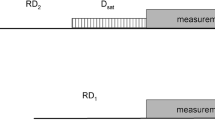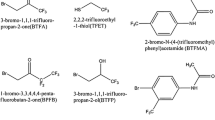Abstract
We present a 13C direct detection CACA-TOCSY experiment for samples with alternate 13C–12C labeling. It provides inter-residue correlations between 13Cα resonances of residue i and adjacent Cαs at positions i − 1 and i + 1. Furthermore, longer mixing times yield correlations to Cα nuclei separated by more than one residue. The experiment also provides Cα-to-sidechain correlations, some amino acid type identifications and estimates for ψ dihedral angles. The power of the experiment derives from the alternate 13C–12C labeling with [1,3-13C] glycerol or [2-13C] glycerol, which allows utilizing the small scalar 3JCC couplings that are masked by strong 1JCC couplings in uniformly 13C labeled samples.





Similar content being viewed by others
References
Arnesano F, Banci L, Piccioli M (2005) NMR structures of paramagnetic metalloproteins. Q Rev Biophys 38:167–219
Balayssac S, Jimenez B, Piccioli M (2006) 13C direct detected COCO-TOCSY: a tool for sequence specific assignment and structure determination in protonless NMR experiments. J Magn Reson 182:325–329
Bermel W, Bertini I, Felli IC, Kummerle R, Pierattelli R (2003) 13C Direct detection experiments on the paramagnetic oxidized monomeric copper zinc superoxide dismutase. J Am Chem Soc 125:16423–16429
Bermel W, Bertini I, Duma L, Felli IC, Emsley L, Pierattelli R, Vasos PR (2005) Complete assignment of heteronuclear protein resonances by protonless NMR spectroscopy. Angew Chem Int Ed Engl 44:3089–3092
Bermel W, Bertini I, Felli IC, Lee YM, Luchinat C, Pierattelli R (2006a) Protonless NMR experiments for sequence-specific assignment of backbone nuclei in unfolded proteins. J Am Chem Soc 128:3918–3919
Bermel W, Bertini I, Felli IC, Piccioli M, Pierattelli R (2006b) 13C-detected protonless NMR spectroscopy of proteins in solution. Prog Nucl Magn Res Spec 48:25–45
Bermel W, Bertini I, Felli IC, Matzapetakis M, Pierattelli R, Theil EC, Turano P (2007) A method for Cα direct-detection in protonless NMR. J Magn Reson 188:301–310
Bermel W, Bertini I, Csizmok V, Felli IC, Pierattelli R, Tompa P (2009a) H-start for exclusively heteronuclear NMR spectroscopy: the case of intrinsically disordered proteins. J Magn Reson 198:275–281
Bermel W, Bertini I, Felli IC, Pierattelli R (2009b) Speeding up 13C direct detection biomolecular NMR spectroscopy. J Am Chem Soc 131:15339–15345
Cai S, Seu C, Kovacs Z, Sherry AD, Chen Y (2006) Sensitivity enhancement of multidimensional NMR experiments by paramagnetic relaxation effects. J Am Chem Soc 128:13474–13478
Castellani F, van Rossum B, Diehl A, Schubert M, Rehbein K, Oschkinat H (2002) Structure of a protein determined by solid-state magic-angle-spinning NMR spectroscopy. Nature 420:98–102
Eletsky A, Moreira O, Kovacs H, Pervushin K (2003) A novel strategy for the assignment of side-chain resonances in completely deuterated large proteins using 13C spectroscopy. J Biomol NMR 26:167–179
Felli I, Brutscher B (2009) Recent advances in solution NMR: fast methods and heteronuclear direct detection. ChemPhysChem 10:1356–1368
Felli I, Pierattelli R, Glaser S, Luy B (2009) Relaxation-optimised Hartmann–Hahn transfer using a specifically Tailored MOCCA-XY16 mixing sequence for carbonyl–carbonyl correlation spectroscopy in 13C direct detection NMR experiments. J Biomol NMR 43:187–196
Frueh DP, Arthanari H, Wagner G (2005) Unambiguous assignment of NMR protein backbone signals with a time-shared triple-resonance experiment. J Biomol NMR 33:187–196
Goddard TD, Kneller DG (2004) SPARKY 3. University of California, San Francisco
Guo C, Geng C, Tugarinov V (2009) Selective backbone labeling of proteins using 1, 2-13C2-pyruvate as carbon source. J Biomol NMR 44:167–173
Hennig M, Bermel W, Schwalbe H, Griesinger C (2000) Determination of ψ torsion angle restraints from 3J(Cα, Cα) and 3J(Cα, HN) coupling constants in proteins. J Am Chem Soc 122:6268–6277
Hsu S-TD, Bertoncini CW, Dobson CM (2009) Use of protonless NMR spectroscopy to alleviate the loss of information resulting from exchange-broadening. J Am Chem Soc 131:7222–7223
Hu J-S, Bax A (1996) Measurement of three-bond 13C–13C J couplings between carbonyl and carbonyl/carboxyl carbons in isotopically enriched proteins. J Am Chem Soc 118:8170–8171
Hyberts SG, Takeuchi K, Wagner G (2010) Poisson-gap sampling and forward maximum entropy reconstruction for enhancing the resolution and sensitivity of protein NMR Data. J Am Chem Soc 132:2145–2147
Lee D, Vögeli B, Pervushin K (2005) Detection of C′, Cα correlations in proteins using a new time- and sensitivity-optimal experiment. J Biomol NMR 31:273–278
LeMaster DM, Kushlan DM (1996) Dynamical mapping of E. coli thioredoxin via 13C NMR relaxation analysis. J Am Chem Soc 118:9255–9264
Liu A, Riek R, Wider G, von Schroetter C, Zahn R, Wuthrich K (2000) NMR experiments for resonance assignments of 13C, 15N doubly-labeled flexible polypeptides: application to the human prion protein hPrP(23–230). J Biomol NMR 16:127–138
Marion D, Ikura M, Tschudin R, Bax A (1989) Rapid recording of 2D NMR spectra without phase cycling. Application to the study of hydrogen exchange in proteins. J Magn Reson 85:393–399
Peti W, Hennig M, Smith LJ, Schwalbe H (2000) NMR spectroscopic investigation of ψ torsion angle distribution in unfolded ubiquitin from analysis of 3J(Cα, Cα) coupling constants and cross-correlated relaxation rates. J Am Chem Soc 122:12017–12018
Serber Z, Richter C, Dotsch V (2001) Carbon-detected NMR experiments to investigate structure and dynamics of biological macromolecules. Chembiochem 2:247–251
Shaka AJ, Keeler J, Frenkiel T, Freeman R (1983) An improved sequence for broadband decoupling: WALTZ-16. J Magn Reson 52:335–338
Shaka AJ, Barker PB, Freeman R (1985) Computer-optimized decoupling scheme for wideband applications and low-level operation. J Magn Reson 64:547–552
Shimba N, Stern AS, Craik CS, Hoch JC, Dotsch V (2003) Elimination of 13Calpha splitting in protein NMR spectra by deconvolution with maximum entropy reconstruction. J Am Chem Soc 125:2382–2383
Takeuchi K, Sun ZY, Wagner G (2008a) Alternate 13C–12C labeling for complete mainchain resonance assignments using C alpha direct-detection with applicability toward fast relaxing protein systems. J Am Chem Soc 130:17210–17211
Takeuchi K, Sun ZY, Wagner G (2008b) Alternate 13C–12C labeling for complete mainchain resonance assignments using Cα direct-detection with applicability toward fast relaxing protein systems. J Am Chem Soc 130:17210–17211
Takeuchi K, Frueh DP, Hyberts SG, Sun ZJ, Wagner G (2010) High-resolution 3D CANCA NMR experiments for complete mainchain assignments using Cα direct-detection. J Am Chem Soc 132:2945–2951
Acknowledgments
Dr. Tsyr-Yan (Dharma) Yu, Dr. Arthanari Haribabu, and Dr. Alexander Koglin are acknowledged for stimulating discussions. This work was supported by the NIH (grants AI37581, GM47467 and EB 002026).
Author information
Authors and Affiliations
Corresponding author
Electronic supplementary material
Below is the link to the electronic supplementary material.
Rights and permissions
About this article
Cite this article
Takeuchi, K., Frueh, D.P., Sun, ZY.J. et al. CACA-TOCSY with alternate 13C–12C labeling: a 13Cα direct detection experiment for mainchain resonance assignment, dihedral angle information, and amino acid type identification. J Biomol NMR 47, 55–63 (2010). https://doi.org/10.1007/s10858-010-9410-3
Received:
Accepted:
Published:
Issue Date:
DOI: https://doi.org/10.1007/s10858-010-9410-3




